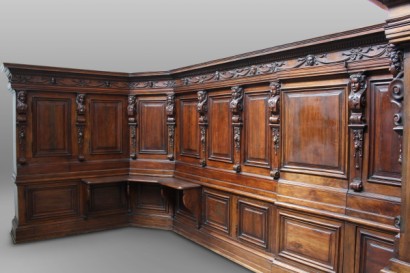Wainscoting-Library
Features
Style: Baroque (1630-1730)
Age: 17th Century / 1601 - 1700
Origin: Lombardia, Italy
Main essence: Walnut
Material: Solid Walnut
Description
The library made from a ancient wall, probably the fixed part of a choir. Solid walnut, the boiserie is composed of two parts, one to corner and a horseshoe with a gate inserted. The décor has a low order of ante and one at the top where the doors are from a series of carved pilasters ending with Cherubim. The pediment is decorated with carved masks and garlands by siding with bow tassels. The original structure was modified in order to achieve a boiserie with library function and therefore fixed panels were turned into doors and interiors built specifically.
Product Condition:
Requires restoration and resumption of polishing.
Dimensions (cm):
Height: 210
Width: 1000
Depth: 54
Additional Information
Style: Baroque (1630-1730)
Read more
The term derives from the Spanish barrueco phoneme or Portuguese barroco and literally means "shapeless pearl".
Already around the middle of the eighteenth century in France it was synonymous with uneven, irregular, bizarre, while in Italy the term was of Medieval memory and indicated a figure of the syllogism, an abstraction of thought.
This historical period was identified with the derogatory term baroque, recognizing in it extravagance and contrast with the criteria of harmony and expressive rigor to which it was intended to return under the influence of Greco-Roman art and the Italian Renaissance.
Baroque, seventeenth-century and seventeenth-century were synonymous with bad taste.
As regards furniture, freedom of ideation, need for pomp and virtuosity gave rise to a synergy destined to produce unsurpassed masterpieces.
The materials used were worthy of competing with the most astonishing tales of Marco Polo: lapis lazuli, malachite, amber, ivory, tortoiseshell, gold, silver, steel, precious wood essences and more dressed the furnishings that in shape and imagination virtually gave life to the Arabian Nights of many of our powerful people.
Typical of the period were load-bearing or accessory parts resolved with twisted column motifs, clearly inspired by Bernini's canopy of St. Peter's, parts with rich sculptural carving in high relief and even in the round within a vortex of volutes, scrolls and spirals, curved and broken profiles, cymatiums agitated by gables of articulated shape, aprons adorned with ornaments, corbels, buttresses and so on. necessary to enliven shapes and structures.
The Baroque is also the century of illusionism: lacquers and thin temperas crowd furniture and furnishings to imitate with the marbling effects of marble veining or games of veining of precious briar roots.
Find out more about the Baroque with our insights:
Classic Monday: a double-body sideboard, late Venetian Baroque
Classic Monday: a pair of candle holders between the Renaissance and Baroque
Classic Monday: a pair of mirrors between Baroque and Late Baroque





















